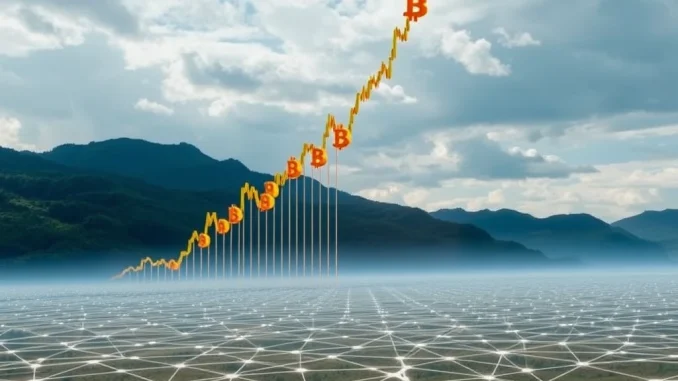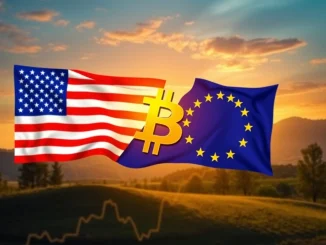
The recent Bitcoin price surge has left many in the crypto market scratching their heads. Typically, a significant price increase is accompanied by a flurry of activity on the network itself – new wallets, increased transaction volume, higher fees. This organic activity is often seen as a sign of genuine user adoption and demand. However, according to analyst J.A. Maartunn, that hasn’t been the case this time around.
Understanding On-Chain Demand
What exactly is on-chain demand? It refers to the economic activity happening directly on the Bitcoin blockchain. This includes:
- The number of active addresses sending or receiving Bitcoin.
- The total transaction volume (value transferred).
- The number of new addresses being created.
- Transaction fees paid (indicating competition for block space).
High on-chain demand usually signals that more people are using Bitcoin for transactions, speculation, or long-term holding directly on the network. It’s often considered a fundamental indicator of network health and organic growth.
Why the Current Bitcoin Price Surge is Different
J.A. Maartunn highlighted on X that despite the impressive run-up in price, the Bitcoin network appears unusually quiet. He described it as a ‘ghost town’ from an on-chain perspective. This suggests that the buying pressure driving the price isn’t originating from typical users transacting on the blockchain.
This presents a fascinating paradox: price is going up significantly, but the underlying network activity isn’t reflecting that same level of enthusiasm. It challenges the conventional wisdom that price movements must be validated by on-chain metrics.
The Real Drivers: Bitcoin ETFs and Bitcoin Futures
If organic on-chain demand isn’t the primary force, what is? Maartunn points to two major culprits: inflows into U.S. spot Bitcoin ETFs and rising Bitcoin futures open interest (OI).
Spot Bitcoin ETFs: Since their approval and launch in the U.S., these investment vehicles have seen substantial inflows from institutional and retail investors. When investors buy shares in a spot Bitcoin ETF, the ETF provider buys actual Bitcoin to back those shares. This creates significant buying pressure on the market without requiring the end investor to ever touch Bitcoin directly or interact with the blockchain. This explains price appreciation without corresponding on-chain user activity.
Bitcoin Futures Open Interest: Futures contracts allow traders to speculate on the future price of Bitcoin. Rising open interest in futures markets indicates increased leveraged bets on Bitcoin’s price direction. While not directly buying spot Bitcoin, this activity influences price discovery and can create significant market momentum, attracting further speculation and capital. This market activity also happens off the main Bitcoin blockchain.
What Does This Mean for the Crypto Market?
This shift in price drivers has important implications for the crypto market:
- Changing Market Structure: The influence of regulated financial products like ETFs and futures is growing relative to direct on-chain participation.
- New Investor Base: The surge is potentially driven more by traditional finance participants comfortable with ETFs and futures than by crypto-native users.
- On-Chain Metrics Limitations: Traditional on-chain analysis might become less predictive of short-term price movements if off-chain factors dominate.
- Liquidity and Volatility: Large inflows into ETFs can provide significant liquidity, but market movements tied to financial derivatives like futures can also introduce new forms of volatility.
Investors and analysts who rely heavily on on-chain data need to adapt their frameworks to include the impact of these powerful off-chain forces. The market dynamics are evolving.
Looking Ahead: Will On-Chain Activity Catch Up?
The big question is whether this divergence between price and on-chain demand is sustainable. Some argue that sustained price increases eventually attract new users who *do* interact directly with the network, causing on-chain activity to rise and validate the move. Others worry that a market driven primarily by financial instruments might be more susceptible to rapid reversals based on broader market sentiment or regulatory changes rather than fundamental network use.
Monitoring both the inflows into Bitcoin ETFs and the activity in Bitcoin futures markets, alongside traditional on-chain indicators, will be crucial for understanding the market’s direction.
Conclusion
The recent Bitcoin price surge, occurring with notably low on-chain demand, highlights the increasing influence of traditional financial vehicles like spot Bitcoin ETFs and Bitcoin futures on the crypto market. As pointed out by analyst J.A. Maartunn, these off-chain factors appear to be the primary engines driving price appreciation. This signals a maturation of the market, attracting capital through regulated channels, but also suggests that traditional on-chain analysis must now be considered alongside these powerful new forces. Understanding this evolving dynamic is key for navigating the current market landscape.



